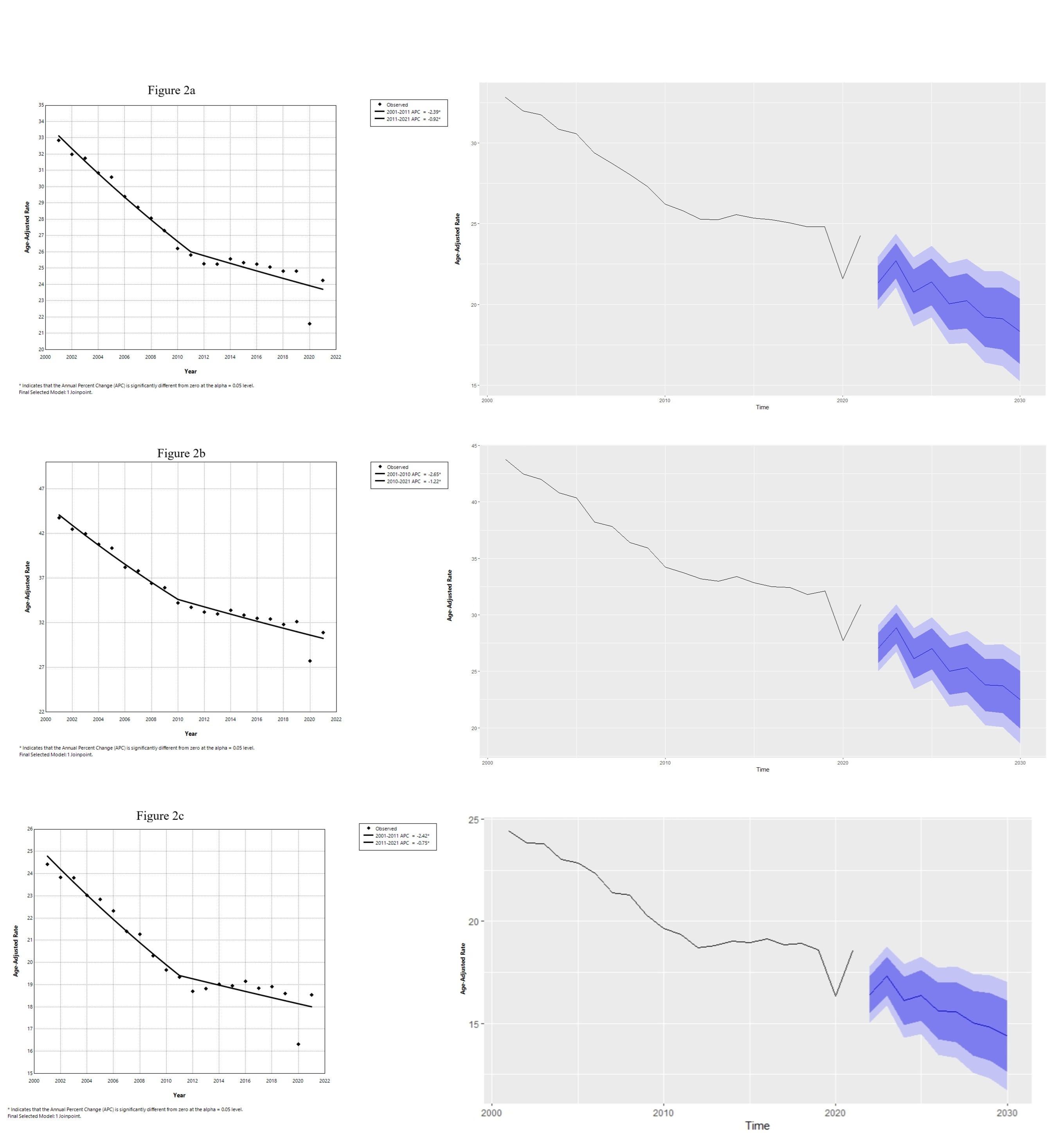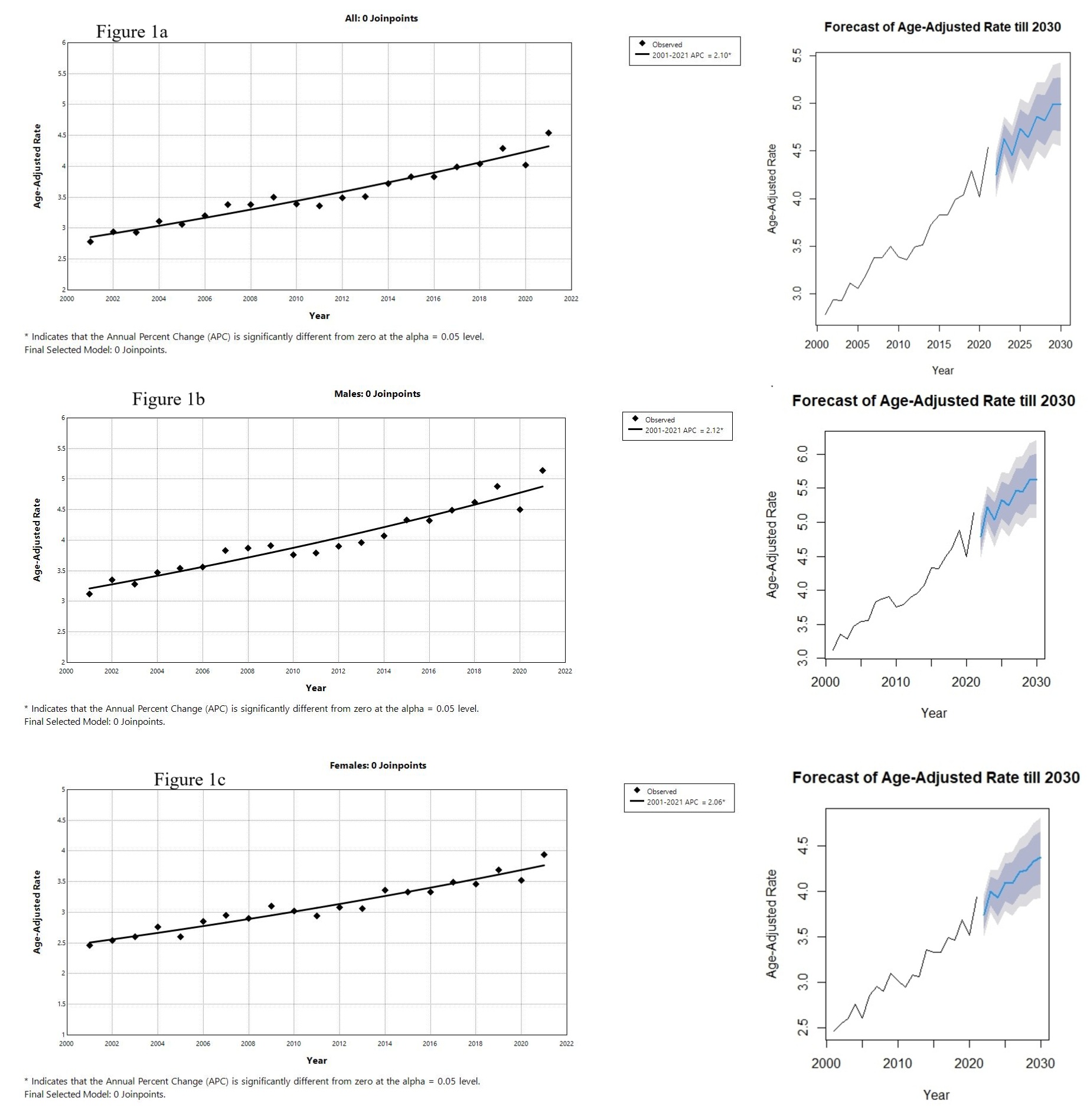Tuesday Poster Session
Category: Colorectal Cancer Prevention
P4789 - Conflicting Trends in the Incidence of Rectal Cancer Among Young vs Old Adults in the United States and Establishing a Predictive Model to 2030
Tuesday, October 28, 2025
10:30 AM - 4:00 PM PDT
Location: Exhibit Hall
- RV
Renuka Verma, MD (she/her/hers)
Kirk Kerkorian School of Medicine at the University of Nevada Las Vegas
Las Vegas, NV
Presenting Author(s)
Renuka Verma, MD1, Kristie Liao, DO2, Kamleshun Ramphul, MD3, Vignan Manne, MD1
1Kirk Kerkorian School of Medicine at the University of Nevada Las Vegas, Las Vegas, NV; 2University of Tennessee Health Science Center, Chattanooga, TN; 3Independent researcher, Las Vegas, NV
Introduction: Despite ongoing efforts in screening and awareness, recent reports confirm a rising trend in colon cancer among young adults, while incidence has declined among older adults in the U.S. This study investigates rectal cancer incidence from 2001 to 2021 and projects future trends to 2030
Methods: We analyzed data from the United States Cancer Statistics (USCS), compiled by the CDC and NCI, for adults aged 20–49 and ≥50 years, stratified by sex. Age-adjusted incidence rates per 100,000 were calculated. Joinpoint regression estimated Annual Percent Change (APC) and Average Annual Percent Change (AAPC) where appropriate. Using RStudio, we built an ARIMA time series model to forecast 2030 incidence. Model performance was assessed using the Ljung-Box test, RMSE, and Augmented Dickey-Fuller test.
Results: Between 2001 and 2021, the incidence of rectal cancer among young adults aged 20-49 rose from 2.78 to 4.54 per 100,000 (APC: 2.10, p < 0.05), with similar trends in males (3.12 to 5.14, APC: 2.12, p < 0.05) and females (2.46 to 3.94, APC: 2.06, p < 0.05). The predictive models estimate that by 2030, the age-adjusted incidence among young adults will reach 4.99 per 100,000, 5.64 for males, and 4.37 for females. Meanwhile, among adults aged 50+, the incidence dropped from 32.85 in 2001 to 25.81 in 2011 (APC: 2.39, p < 0.01) and to 24.25 in 2021 (APC: 0.92, p = 0.011; AAPC: 1.66, p < 0.01). Among males, the rate fell from 43.77 in 2001 to 34.23 in 2010 (APC: 2.65, p < 0.01), and to 30.90 by 2021 (APC: 1.22, p < 0.01; AAPC: 1.87, p < 0.01). For females, it declined from 24.42 in 2001 to 19.34 in 2011 (APC: 2.42, p < 0.01) and 18.54 in 2021 (APC: 0.73, p = 0.043; AAPC: 1.59, p < 0.01). By 2030, incidence among adults 50+ is projected to fall to 18.33 per 100,000, 22.48 for males, and 14.37 for females.
Discussion: Our study identifies that there is an increasing trend in rectal cancer among young adults. We encourage the reevaluation of the current guidelines to incorporate earlier and more frequent screening.

Figure: Figure 1a- Trends in incidence of rectal cancer among young adults (males + females) and forecast till 2030
Figure 1b- Trends in incidence of rectal cancer among young male adults and forecast till 2030
Figure 1c- Trends in incidence of rectal cancer among young female adults and forecast till 2030

Figure: Figure 2a- Trends in incidence of rectal cancer among old adults (males+females) and forecast till 2030
Figure 2b- Trends in incidence of rectal cancer among old male adults and forecast till 2030
Figure 2c- Trends in incidence of rectal cancer among old female adults and forecast till 2030
Disclosures:
Renuka Verma indicated no relevant financial relationships.
Kristie Liao indicated no relevant financial relationships.
Kamleshun Ramphul indicated no relevant financial relationships.
Vignan Manne indicated no relevant financial relationships.
Renuka Verma, MD1, Kristie Liao, DO2, Kamleshun Ramphul, MD3, Vignan Manne, MD1. P4789 - Conflicting Trends in the Incidence of Rectal Cancer Among Young vs Old Adults in the United States and Establishing a Predictive Model to 2030, ACG 2025 Annual Scientific Meeting Abstracts. Phoenix, AZ: American College of Gastroenterology.
1Kirk Kerkorian School of Medicine at the University of Nevada Las Vegas, Las Vegas, NV; 2University of Tennessee Health Science Center, Chattanooga, TN; 3Independent researcher, Las Vegas, NV
Introduction: Despite ongoing efforts in screening and awareness, recent reports confirm a rising trend in colon cancer among young adults, while incidence has declined among older adults in the U.S. This study investigates rectal cancer incidence from 2001 to 2021 and projects future trends to 2030
Methods: We analyzed data from the United States Cancer Statistics (USCS), compiled by the CDC and NCI, for adults aged 20–49 and ≥50 years, stratified by sex. Age-adjusted incidence rates per 100,000 were calculated. Joinpoint regression estimated Annual Percent Change (APC) and Average Annual Percent Change (AAPC) where appropriate. Using RStudio, we built an ARIMA time series model to forecast 2030 incidence. Model performance was assessed using the Ljung-Box test, RMSE, and Augmented Dickey-Fuller test.
Results: Between 2001 and 2021, the incidence of rectal cancer among young adults aged 20-49 rose from 2.78 to 4.54 per 100,000 (APC: 2.10, p < 0.05), with similar trends in males (3.12 to 5.14, APC: 2.12, p < 0.05) and females (2.46 to 3.94, APC: 2.06, p < 0.05). The predictive models estimate that by 2030, the age-adjusted incidence among young adults will reach 4.99 per 100,000, 5.64 for males, and 4.37 for females. Meanwhile, among adults aged 50+, the incidence dropped from 32.85 in 2001 to 25.81 in 2011 (APC: 2.39, p < 0.01) and to 24.25 in 2021 (APC: 0.92, p = 0.011; AAPC: 1.66, p < 0.01). Among males, the rate fell from 43.77 in 2001 to 34.23 in 2010 (APC: 2.65, p < 0.01), and to 30.90 by 2021 (APC: 1.22, p < 0.01; AAPC: 1.87, p < 0.01). For females, it declined from 24.42 in 2001 to 19.34 in 2011 (APC: 2.42, p < 0.01) and 18.54 in 2021 (APC: 0.73, p = 0.043; AAPC: 1.59, p < 0.01). By 2030, incidence among adults 50+ is projected to fall to 18.33 per 100,000, 22.48 for males, and 14.37 for females.
Discussion: Our study identifies that there is an increasing trend in rectal cancer among young adults. We encourage the reevaluation of the current guidelines to incorporate earlier and more frequent screening.

Figure: Figure 1a- Trends in incidence of rectal cancer among young adults (males + females) and forecast till 2030
Figure 1b- Trends in incidence of rectal cancer among young male adults and forecast till 2030
Figure 1c- Trends in incidence of rectal cancer among young female adults and forecast till 2030

Figure: Figure 2a- Trends in incidence of rectal cancer among old adults (males+females) and forecast till 2030
Figure 2b- Trends in incidence of rectal cancer among old male adults and forecast till 2030
Figure 2c- Trends in incidence of rectal cancer among old female adults and forecast till 2030
Disclosures:
Renuka Verma indicated no relevant financial relationships.
Kristie Liao indicated no relevant financial relationships.
Kamleshun Ramphul indicated no relevant financial relationships.
Vignan Manne indicated no relevant financial relationships.
Renuka Verma, MD1, Kristie Liao, DO2, Kamleshun Ramphul, MD3, Vignan Manne, MD1. P4789 - Conflicting Trends in the Incidence of Rectal Cancer Among Young vs Old Adults in the United States and Establishing a Predictive Model to 2030, ACG 2025 Annual Scientific Meeting Abstracts. Phoenix, AZ: American College of Gastroenterology.
